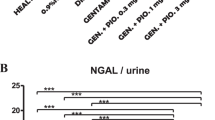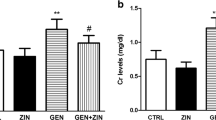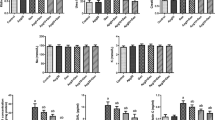Abstract
Nephrotoxicity is a major complication of gentamicin (GEN), which is widely used in the treatment of severe gram-negative infections. Reactive oxygen spaces (ROS) are important mediators of gentamicin-induced nephrotoxicity. Peroxisome proliferator-activated receptors (PPARs) have different activities including antioxidant properties. This study was performed to investigate the protective role of PPAR-γ agonist against GEN-induced nephrotoxicity. Male Wistar Albino rats were randomly divided into the following four groups, each of which consisted of six animals: (1) control; (2) intraperitoneally injected with GEN for 14 consecutive days (100 mg/kg/day); (3) treatment with rosiglitazone (RSG) via nasogastric gavage (10 mg/kg/daily for 14 days); (4) treatment with GEN + RSG combination for 14 day. Rats were decapitated on the 15th day and kidneys were removed. Urine was collected for every 24 h for the determination of daily urine volume. Urea, creatinine, Na+ and K+ levels were measured in blood. Malondialdehyde (MDA), reduced glutathion (GSH), and nitric oxide (NO) levels along with glutathione peroxidase (GSH-Px), catalase (CAT), and superoxide dismutase (SOD) activities were determined in the renal tissue. Changes in body weight were recorded. GEN treatment was found to cause nephrotoxicity as evidenced by elevation of serum urea and creatinine levels. Renal impairment was also assessed by the renal histology. The significant decrease in GSH and increases in MDA and NO levels as well as a decrease in GSH-Px, CAT, and SOD activities indicated that GEN-induced renal damage was mediated through oxidative reactions. On the other hand, RSG administration protected kidney tissue against GEN-induced and free radical-mediated oxidative renal damage in rats.

Similar content being viewed by others
References
Humes HD, Weinberg JM (1986) Toxic nephropathies. In: Brenner BM, Rector FC (eds) The kidney. WB Saunders Co., Philadelphia, pp 1491–1532
Edson RS, Terrell CL (1999) The aminoglycosides. Mayo Clin Proc 74:519–528
Cuzzocrea S, Mazzon E, Dugo L et al (2002) A role for superoxide in gentamicin-mediated nephropathy in rats. Eur J Pharmacol 450:67–76
Yanagida C, Ito K, Komiya I et al (2004) Protective effect of fosfomycin on gentamicin-induced lipid peroxidation of rat renal tissue. Chem Biol Interact 148:139–147
Grune T, Sommerburg O, Petras T et al (1995) Postanoxic formation of aldehydic lipid peroxidation products in human renal tubular cells. Free Radic Biol Med 18:21–27
Baliga R, Ueda N, Walker PD et al (1999) Oxidant mechanisms in toxic acute renal failure. Drug Metab Rev 31:971–997
Winterbourn CC, Pichorner H, Kettle AJ (1997) Myeloperoxidase-dependent generation of a tyrosine peroxide by neutrophils. Arch Biochem Biophys 338:15–21
Fryer MJ (1997) Vitamin E may slow kidney failure owing to oxidative stress. Redox Rep 3:259–261
Pedraza-Chaverrí J, Maldonado PD, Medina-Campos ON et al (2000) Garlic ameliorates gentamicin nephrotoxicity: relation to antioxidant enzymes. Free Radic Biol Med 29:602–611
Marx N, Bourcier T, Sukhova GK et al (1999) PPAR γ activation in human endothelial cells increases plasminogen activator inhibitor type-1 expression: PPAR γ as a potential mediator in vascular disease. Arterioscler Thromb Vasc Biol 19:546–551
Cuzzocrea S, Mazzon E, Di Paola R et al (2006) The role of the peroxisome proliferator-activated receptor-α (PPAR-α) in the regulation of acute inflammation. J Leukoc Biol 79:999–1010
Toba H, Miki S, Shimizu T et al (2006) The direct antioxidative and anti-inflammatory effects of peroxisome proliferator-activated receptors ligands are associated with the inhibition of angiotensin converting enzyme expression in streptozotocin-induced diabetic rat aorta. Eur J Pharmacol 549:124–132
Liu D, Zeng BX, Zhang SH et al (2005) Rosiglitazone, an agonist of peroxisome proliferator-activated receptor γ, reduces pulmonary inflammatory response in a rat model of endotoxemia. Inflamm Res 54:464–470
Sánchez-Hidalgo M, Martín AR, Villegas I et al (2005) Rosiglitazone, an agonist of peroxisome proliferator-activated receptor γ, reduces chronic colonic inflammation in rats. Biochem Pharmacol 69:1733–1744
Abdelrahman M, Sivarajah A, Thiemermann C (2005) Beneficial effects of PPAR-γ ligands in ischemia–reperfusion injury, inflammation and shock. Cardiovasc Res 65:772–781
Villegas I, Martín AR, Toma W et al (2004) Rosiglitazone, an agonist of peroxisome proliferator-activated receptor γ, protects against gastric ischemia–reperfusion damage in rats: role of oxygen free radicals generation. Eur J Pharmacol 505:195–203
Wasowicz W, Neve J, Peretz A (1993) Optimized steps in fluorometric determination thiobarbituric acid-reactive substances in serum: importance of extraction pH and influence sample preservation and storage. Clin Chem 39:2522–2528
Beutler E (1975) Glutathione in red blood cell metabolism. A manual of biochemical methods. Grune and Stratton, New York, pp 112–114
Granger DL, Taintor RR, Boockvar KS et al (1999) Measurement of nitrate and nitrite in biological samples using nitrate reductase and Griess reaction. Methods Enzymol 268:142–151
Paglia D, Valentine WN (1967) Studies on the quantitative and qualitative characterization of erythrocyte glutathione peroxidase. J Lab Clin Med 70:158–163
Aebi H (1982) Catalase. In: Bergmeyer HU (ed) Methods in enzymatic analysis. Verlag Chemic, Weinheim, pp 273–282
Sun Y, Oberley LW, Li Y (1988) A simple method for clinical assay of superoxide dismutase. Clin Chem 34:497–500
Allen CT (1992) Laboratory methods in histochemistry. In: Prophet EB, Mills B, Arrington JB, Sobin LH (eds) American registry of pathology, 1st edn. Washington DC, p 53
Tariq M, Morais C, Sobki S et al (1999) N-acetylcysteine attenuates cyclosporin-induced nephrotoxicity in rats. Nephrol Dial Transplant 14:923–929
Humes HD (1988) Aminoglycoside nephrotoxicity. Kidney Int 33:900–911
Powell JH, Reidenberg MM (1983) Further studies of the response of kidney lysosomes to aminoglycosides and other cations. Biochem Pharmacol 32:3213–3220
Simmons CF Jr, Bogusky RT, Humes HD (1980) Inhibitory effects of gentamicin on renal mitochondrial oxidative phosphorylation. J Pharmacol Exp Ther 214:709–715
Abdel-Gayoum AA, Bashir AA, el-Fakhri MM (1995) Effects of fish oil and sunflower oil supplementations on gentamicin-induced nephrotoxicity in rat. Hum Exp Toxicol 14:884–888
Kasiske BL, O’Donnell MP, Cleary MP et al (1989) Effects of reduced renal mass on tissue lipids and renal injury in hyperlipidemic rats. Kidney Int 35:40–47
Maegawa H, Nishio Y, Nakao K et al (2007) Short-term low-dosage pioglitazone treatment improves vascular dysfunction in patients with type 2 diabetes. Endocr J 54:613–618
Matsumoto T, Kakami M, Noguchi E et al (2007) Imbalance between endothelium-derived relaxing and contracting factors in mesenteric arteries from aged OLETF rats, a model of type 2 diabetes. Am J Physiol Heart Circ Physiol 293:H1480–H1490
Persson PB (2002) Nitric oxide in the kidney. Am J Physiol Regul Integr Comp Physiol 283:R1005–R1007
Juncos LA, Garvin J, Carretero OA et al (1995) Flow modulates myogenic responses in isolated microperfused rabbit afferent arterioles via endothelium-derived nitric oxide. J Clin Invest 95:2478–2741
Gabbai FB, Blantz RC (1999) Role of nitric oxide in renal hemodynamics. Semin Nephrol 19:242–250
Pistrosch F, Herbrig K, Kindel B et al (2005) Rosiglitazone improves glomerular hyperfiltration, renal endothelial dysfunction, and microalbuminuria of incipient diabetic nephropathy in patients. Diabetes 54:2206–2211
Komers R, Vrána A (1998) Thiazolidinediones-tools for the research of metabolic syndrome X. Physiol Res 47:215–225
Song J, Knepper MA, Hu X et al (2004) Rosiglitazone activates renal sodium- and water-reabsorptive pathways and lowers blood pressure in normal rats. J Pharmacol Exp Ther 308:426–433
Walker PD, Barri Y, Shah SV (1999) Oxidant mechanisms in gentamicin nephrotoxicity. Ren Fail 21:433–442
Yang CL, Du XH, Han YX (1995) Renal cortical mitochondria are the source of oxygen free radicals enhanced by gentamicin. Ren Fail 17:21–26
Ross D (1988) Glutathione, free radicals and chemotherapeutic agents. Mechanisms of free-radical induced toxicity and glutathione-dependent protection. Pharmacol Ther 37:231–249
McCord JM, Keele BB Jr, Fridovich I (1971) An enzyme-based theory of obligate anaerobiosis: the physiological function of superoxide dismutase. Proc Natl Acad Sci USA 68:1024–1027
Freeman BA, Crapo JD (1982) Biology of disease: free radicals and tissue injury. Lab Invest 47:412–426
Lee S, Kim W, Moon SO et al (2006) Rosiglitazone ameliorates cisplatin-induced renal injury in mice. Nephrol Dial Transplant 21:2096–2105
Author information
Authors and Affiliations
Corresponding author
Rights and permissions
About this article
Cite this article
Ozbek, E., Ilbey, Y.O., Simsek, A. et al. Rosiglitazone, peroxisome proliferator receptor-gamma agonist, ameliorates gentamicin-induced nephrotoxicity in rats. Int Urol Nephrol 42, 579–587 (2010). https://doi.org/10.1007/s11255-009-9645-7
Received:
Accepted:
Published:
Issue Date:
DOI: https://doi.org/10.1007/s11255-009-9645-7




